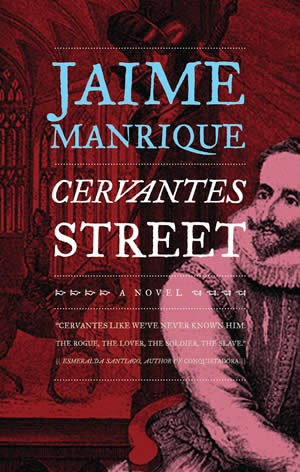 Aisles
Aisles
Missing Episodes from
the Man of La Mancha
Cervantes Street
by Jaime Manrique
Review by Holly Laycock
 he little we do know about Miguel Cervantes' life provides a story rich enough to write itself. Born to a family with few prospects, a young Miguel became an exile of Spain after nearly killing a man in a duel, lost the use of his left arm in a battle years later, was captured by a pirate fleet and sold into slavery in Algiers, only to end up in a remote corner of his homeland, La Mancha, where he wrote one of the most revered novels in history.
he little we do know about Miguel Cervantes' life provides a story rich enough to write itself. Born to a family with few prospects, a young Miguel became an exile of Spain after nearly killing a man in a duel, lost the use of his left arm in a battle years later, was captured by a pirate fleet and sold into slavery in Algiers, only to end up in a remote corner of his homeland, La Mancha, where he wrote one of the most revered novels in history.
The facts alone are impressive, but the life and times of Miguel de Cervantes come to life in the transitions of Jaime Manrique's novel, Cervantes Street. In Manrique's fictional account, a dueling narrative develops between Miguel and friend-turned-arch-enemy Luis Lara. Luis devotes his life to Miguel's ruin when he learns of the love affair between the famous author and his betrothed, and Manrique proffers this betrayal as one explanation for the mystery-shrouded false sequel to Cervantes' Don Quixote—the insecure and devastatingly envious Luis seeks to outshine one of the most celebrated books in all of history by writing a better sequel. This aspect of the plot becomes a tad predictable by the end of the novel, but is a driving force nonetheless.
Manrique appropriates from Cervantes' written work throughout the novel, and his paraphrased interpretations of scenes and characters (such as the bumbling Sancho Panza) are indistinguishable to the unfamiliar eye, yet rich with the sensory detail and comic musings of Cervantes' own language. During Miguel's period of captivity in Algiers, he makes money for food by telling stories at the marketplace, and in an interaction with another captive, the maxim-ridden insight of Cervantes emerges in Manrique's prose:
"All tales need a love affair and a suffering and beautiful heroine. I don't want to hear a story unless it is about love, and the sadder the better. Look," she pointed to a huge basket filled with dirty laundry that she had set on the ground by her feet, "that's my work every day, if I want to eat and not be lashed. I will shed my tears over young, beautiful, rich lovers who are doomed to die for love. I don't want to weep over my own wretched life. Young man, take me someplace away from here, where I can forget about this shit-hole and these mountains of filthy clothes I see even in my dreams. That's what I want from a story."
Whether you're familiar with Don Quixote or not, Manrique's command of 16th Century Spanish history is evident in his patchwork retelling of Cervantes’ life. Details like the price a book would sell for in Madrid in the 1600’s, the nitty gritty descriptions of conditions for a prisoner aboard a pirate ship, or the particulars regarding race and religion during the Spanish Inquisition enrich the few things we know about Cervantes’ life into a robust and magnetic story, one where the fictional Miguel de Cervantes is not dissimilar to his greatest character.
 Also in this issue, Holly Laycock reviews Hot Art by Joshua Knelman.
Also in this issue, Holly Laycock reviews Hot Art by Joshua Knelman.


